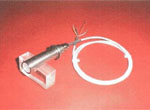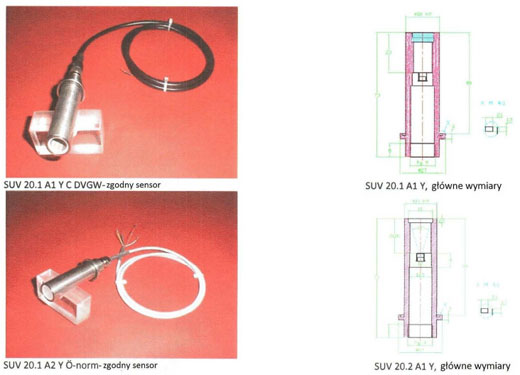 |
 |
|
SUV 20.1 A1 Y (for DVGW) or SUV 20.1 A2 Y (for ÖNORM) UV sensors |
| |
 These sensors are appropriate for the monitoring of radiation intensity of UV lamps in accordance with the DVGW guideline W 294 (10/97) and the ÖNORM M5873-1 standard (03/2001) respectively. They are designed to be installed in the FUV 38 measurement window if used in a water reactor. These sensors are appropriate for the monitoring of radiation intensity of UV lamps in accordance with the DVGW guideline W 294 (10/97) and the ÖNORM M5873-1 standard (03/2001) respectively. They are designed to be installed in the FUV 38 measurement window if used in a water reactor.
Main features are:
-
SiC-based sensor; therefore unaffected by daylight and only sensitive to UV light
-
UV-C filter already integrated
-
Probe body in stainless steel, insertion area 20 x 59 mm diameter, overall length 73 mm, with collar and groove
for ”O” ring 18.77 x 1.78
-
Entry window for UV: ∅ 12.0 mm; angle of opening 30° (DVGW), 160° (ÖNORM)
-
Operating temperature: 0 to +60°C; 100°C for brief periods, storage temperature: -20 to +70°C
-
Standard version has PG7 screw cable fitting with kink guard and 5 m cable
-
Electronics as per DVGW standard or Ö-norm already integrated
-
Option A1 (DVGW): sealed and watertight with a window admitting UV radiation, pressure resistant up to 1
bar
-
Option A2 (ÖNORM): as A1 but with additional diffusion screen below the window.
Please note: Both types are only pressure resistant up to 16 bar overpressure and for short time down to 1 bar
sub-atmospheric pressure if installed with the measurement window FUV 38.
-
Option C: Series 763 flanged plug, watertight to IP65 when screwed in, a suitable Z1G connector cable (5 m of
5-pole cable with open end) is to be ordered separately
-
Option Y1: voltage output 0 – 2V DC (4,5 V DC max.), supply voltage 5 - 24 V DC, stabilised
-
Option Y2: current output 4 - 20 mA, supply 24V DC, apparent ohmic resistance 500 Ohm max.
-
Standard calibration Emax=50 W/m² or 100 W/m² equivalent to 2V (Option Y1) or 20 mA (Option Y2),
customised calibration upon request
-
On request it is possible to supply this type of sensor in compliance with the latest (04/2003) DVGW proposal
or the ÖNORM M5873-2 of 06/2002.
-
A value-for-money alternative is to order the sensor without integrated electronics, but then will not comply
with the DVGW guideline or the ÖNORM anymore.
|
 |
| |
|
 |
|
|
|
|
|